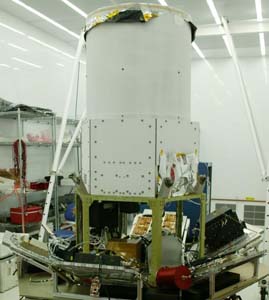The Air  Force Research Lab has moved back the launch date of its tactical satellite-3 until January to fix an issue with the spacecraft’s star tracker so that it will be able to position itself correctly once on orbit. Thom Davis, TacSat-3 program manager within AFRL’s space vehicles directorate at Kirtland AFB, N.M., said the technical issues with the star tracker required modifications to the satellite. “We also needed some extra time to finish baseline functional testing of the flight software,” he said in a release from AFRL Oct. 31. Before the issue arose, the Air Force had anticipated launching the experimental satellite in October from NASA’s Wallops Flight Facility at Wallops Island, Va. The silver lining, said Davis is that the extra time will increase confidence “that all TacSat-3 components will operate efficiently after launch.” TacSat-3 carries three experiments: Raytheon’s ARTEMIS hyperspectral imager, the Office of Naval Research’s satellite communications package, and AFRL’s space avionics experiment. During the satellite’s one-year on-orbit mission, AFRL says it will provide real-time imagery—within 10 minutes of collection—and sea-based information transmitted from ocean buoys to support combatant commanders.
Force Research Lab has moved back the launch date of its tactical satellite-3 until January to fix an issue with the spacecraft’s star tracker so that it will be able to position itself correctly once on orbit. Thom Davis, TacSat-3 program manager within AFRL’s space vehicles directorate at Kirtland AFB, N.M., said the technical issues with the star tracker required modifications to the satellite. “We also needed some extra time to finish baseline functional testing of the flight software,” he said in a release from AFRL Oct. 31. Before the issue arose, the Air Force had anticipated launching the experimental satellite in October from NASA’s Wallops Flight Facility at Wallops Island, Va. The silver lining, said Davis is that the extra time will increase confidence “that all TacSat-3 components will operate efficiently after launch.” TacSat-3 carries three experiments: Raytheon’s ARTEMIS hyperspectral imager, the Office of Naval Research’s satellite communications package, and AFRL’s space avionics experiment. During the satellite’s one-year on-orbit mission, AFRL says it will provide real-time imagery—within 10 minutes of collection—and sea-based information transmitted from ocean buoys to support combatant commanders.
Pentagon Releases Cost of Living, BAH Rates for 2026
Dec. 30, 2025
The Pentagon will pay cost of living allowances to 127,000 service members in the continental U.S. in 2026, an increase of 66,000 members in 2025. Airmen and Guardians across the U.S. will also receive an average increase of 4.2 percent for their Basic Housing Allowance, compared to the 5.4 percent…

